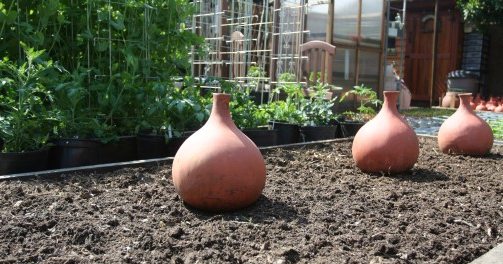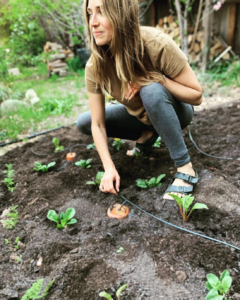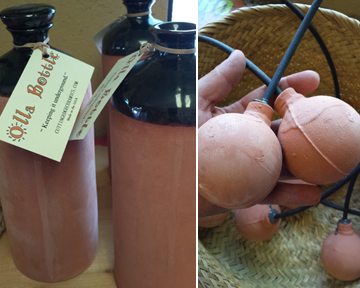Use of low-fired, clay ceramic vessels (ollas) is an ancient technique for the efficient irrigation of crops. First, in use in China and North Africa more than 4,000 years ago, the technique has spread throughout arid regions of the world. The use of ollas (pronounced oh-yahs) can save the gardener time, energy, and water. Olla users report that their vegetable gardens produce more lush plants with higher productivity. Plants watered in this way do not undergo stress cycles due to water and can live and produce longer. Ollas can be a relatively inexpensive way to maximize your garden output while minimizing overwatering, runoff, and water loss.
HOW IT WORKS
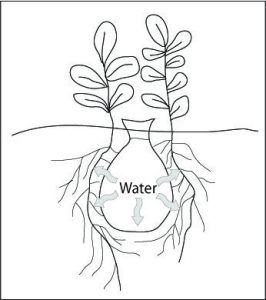 The principle is simple. A clay pot is buried with only the opening on top visible above the soil surface. It is then filled with water. The porous walls of the olla allow for water to dissipate into the soil as needed. Because the pores in the clay pot are small, the water does not freely flow out of the pot. A suction force is created by soil moisture tension as well as the plant roots. If the soil is dry, the water inside the olla will release faster as the soil roots “pull” it out. Likewise, if there is a recent saturating rainfall the water in the olla will remain until the surrounding soil dries. Therefore, olla irrigation is extremely water efficient and prevents excessive evaporation and water runoff.
The principle is simple. A clay pot is buried with only the opening on top visible above the soil surface. It is then filled with water. The porous walls of the olla allow for water to dissipate into the soil as needed. Because the pores in the clay pot are small, the water does not freely flow out of the pot. A suction force is created by soil moisture tension as well as the plant roots. If the soil is dry, the water inside the olla will release faster as the soil roots “pull” it out. Likewise, if there is a recent saturating rainfall the water in the olla will remain until the surrounding soil dries. Therefore, olla irrigation is extremely water efficient and prevents excessive evaporation and water runoff.
It is also better for the root systems of the plants. It promotes deep watering and dense root growth which facilitates more efficient nutrient and water uptake. At the end of the growing season dig up your olla and you will see the efficiency of the olla in action. There will be a dense mat of plant roots. Compare with locations where ollas were not used and the difference is clear.
With ollas, soil and roots do not go through extreme drying and wetting cycles which is particularly beneficial to prevent bitter tasting greens, a challenge to gardening in arid regions. The consistent water also prevents cracks developing in tomatoes or melons which form if plants receive abundant and then scarce water. Additionally, with ollas the soil surface remains relatively dry in gardens which can prevent the growth of weeds and also helps minimize some unwanted insect populations.
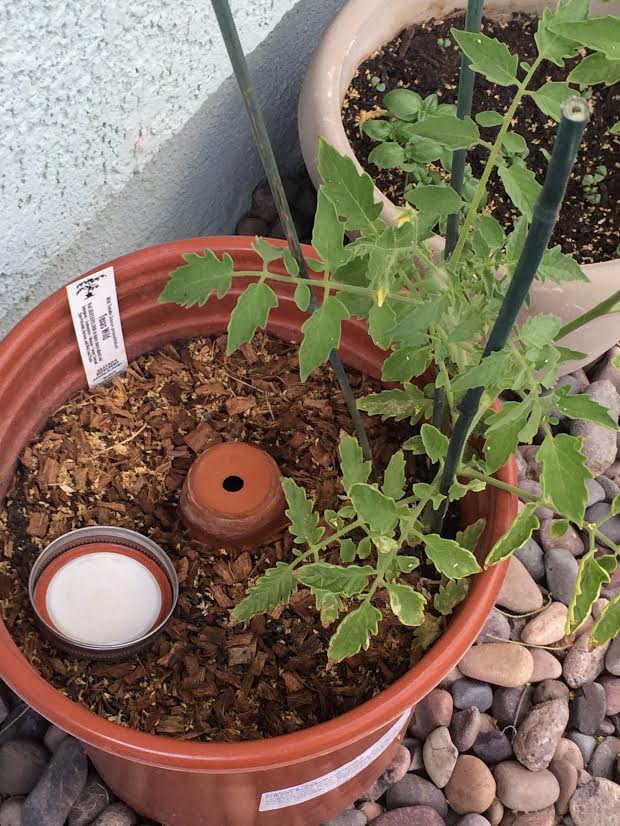
CROPS TO USE
Olla irrigation is most efficient for crops with fibrous root systems like squash, melons, watermelons, tomatoes, and chiles. It is also possible to use ollas with crops with relatively shallow root systems like lettuce and herbs. But keep in mind the shape of the olla and where the water will be. Large round ollas with a thinner neck will seep most of the water below the roots of these crops so initial surface watering may be necessary until they get established.
It is not an efficient technique to use with grains and legumes because of the coverage necessary. It is also difficult because of the expense per olla to use on a larger scale. However, the water cost savings might make it worth it for some crops within a small farm and installing ollas with drip irrigation tape saves on labor for refilling.
Ollas can also be used with perennial landscape plants such as young trees, vines, or bushes. However, some roots of woody vegetation might break the clay olla. If needing to fill the jar more frequently suspect a crack has formed.
TIPS FOR USING OLLAS
- Bury olla leaving 1-2 inches above the surface to prevent dirt and mulch from washing inside. Gently pack soil around the olla. Water will not disperse in air pockets and roots will not grow in air pockets.
- Place ollas at least every 2-3 feet in your garden for maximum impact. Larger ollas with a two-gallon capacity can be placed up to 3-4 feet apart.

Photo Credit: Kate Stone (@katiefrancestone) - Check the water level frequently and refill the olla as needed. The frequency depends upon the soil type, surrounding plant density, and weather. At times it may need refilling every 7 days or more or as frequently as every other day.
- Always keep a rock, plate, or another cover over the olla opening. This will minimize evaporation and prevent mosquito breeding.
- Use ollas in slightly sandy or coarse-textured soils. Soils with high clay content do not dissipate water well.
- If you have a very deep soil it is useful to place a saucer or drainage tray at the bottom of the hole where the olla is to be placed. This impedes water seepage bellow while promoting seepage outward.
- Plant seeds a few inches from the olla opening. Water the entire area and possibly surface water until the seeds germinate if your olla is not keeping the top two inches moist.
- Know where your ollas are buried. Outline the opening with rocks, use a pin flag, or other methods to prevent someone from stepping on the olla.
- If you live in an area that experiences hard freezes, dig up your ollas each winter to prevent them from cracking underground.
- Liquid fertilizer can be added to the olla to slowly release nutrients into the soil. Make sure it is truly a liquid form as to not plug the pores of the clay.
TYPES OF OLLAS
There are several different types of ollas available for purchase and several methods to make your own ollas from clay or store-bought terracotta flower pots. Consider your space, the expense, and how often you are able and willing to refill the ollas, and how long you wish the ollas to last when considering what type to use. There are pros and cons to different types of olla systems.
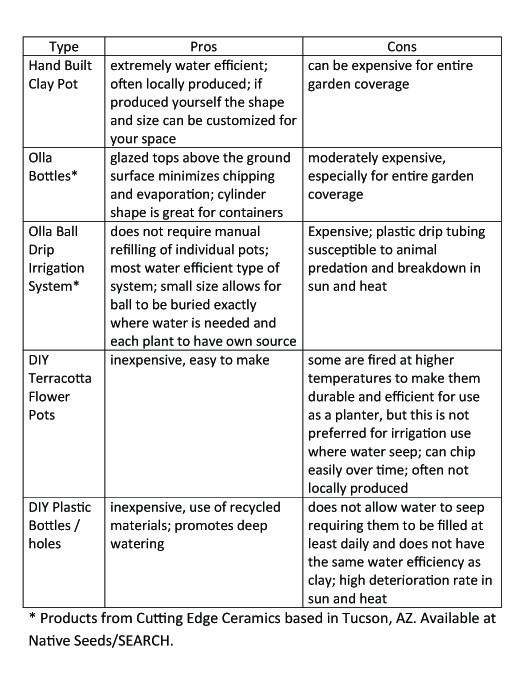
Olla Bottles are very efficient, cylinder-shaped ollas. The glazed tops are great at preventing chipping and evaporation. The shape is perfect for use in large containers but also work well in sunken or raised beds. Olla Balls are clay emitters that use gravity-fed water from a reservoir such as a five-gallon bucket or your rainwater harvesting barrel. Users of olla ball irrigation kits rave about the water savings and increased productivity of their gardens. It really offers the most efficient watering system with relatively no maintenance. If set up with a rainwater harvesting system there is essentially no need to refill making them essentially maintenance free except for repair of damaged or broken lines. These products are locally made in Tucson, Arizona by Cutting Edge Ceramics.
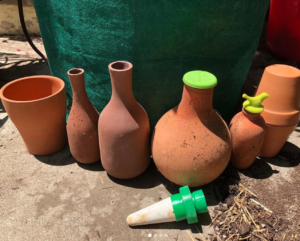
HOW TO MAKE A TERRA COTTA FLOWER POT OLLA
Making your own ollas out of terracotta flower pots is easy and inexpensive. All you will need are two flower pots, a cover for the opening, strong waterproof glue (such as Gorilla Glue), and waterproof silicone caulk. The process can be completed in a few easy steps but will require full drying overnight before installing in your garden.
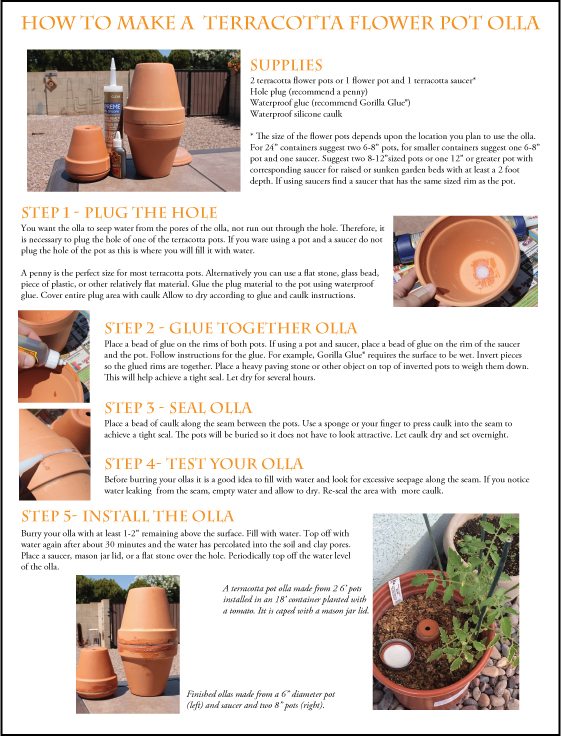
Interested in printing this information to share with others? Please download this condensed 2-page handout.
This article was originally published on May 13, 2016, and is being reprinted with permission. The author of the article, Melissa Kruse-Peeples, is an education program coordinator at Native Seeds/SEARCH (NS/S). Founded in 1983, NS/S is a nonprofit seed conservation organization based in Tucson, Arizona working to collect and preserve endangered, traditional seeds. Their mission is to find, protect, and preserve the seeds of the people of the Greater Southwest so that these arid-adapted crops may benefit all peoples and nourish a changing world.


